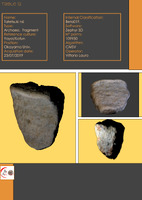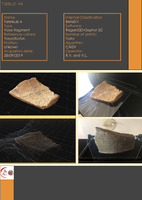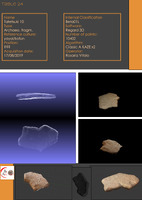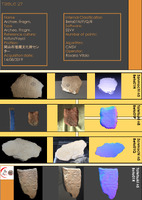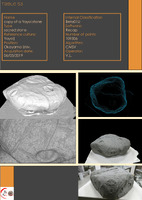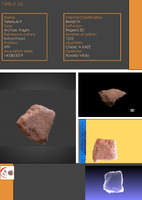検索
2073 items
-
AF TTK 055
Carved stone object with interlocking designs from the Tatetsuki burial mound in Okayama Prefecture -
AF TTK 101 OM Data interpretation
Micromorphology of the surface of ceramic shard. -
AF TTK 101 XRF processing and modelling
XRF quantitative analysis processed by Olympus Vanta software. "Name" is referred to the shard code with a progressive number indicating different measurements spots. "Note" shows the location of measurement spots. The values of the elements are expressed as a percentage by weight. "LE" means light elements i.e. the amount of elements not detectable (Tatetsuki pottery Vanta chemistry XRF results.xlsx). XRF quantitative analysis processed by Olympus Vanta software converted into oxides: SiO2, Al2O3, Fe2O3, CaO, MgO, K2O and TiO2. The conversion to oxides is obtained by multiplying the weight concentration of the element by a conversion factor derived from the ratio of molecular weight of the chosen oxide divided by the atomic weight of the elements. (Tatetsuki pottery Vanta chemistry XRF oxides results.xlsx). -
AF TTK 102 XRF processing and modelling
XRF quantitative analysis processed by Olympus Vanta software. "Name" is referred to the shard code with a progressive number indicating different measurements spots. "Note" shows the location of measurement spots. The values of the elements are expressed as a percentage by weight. "LE" means light elements i.e. the amount of elements not detectable (Tatetsuki pottery Vanta chemistry XRF results.xlsx). XRF quantitative analysis processed by Olympus Vanta software converted into oxides: SiO2, Al2O3, Fe2O3, CaO, MgO, K2O and TiO2. The conversion to oxides is obtained by multiplying the weight concentration of the element by a conversion factor derived from the ratio of molecular weight of the chosen oxide divided by the atomic weight of the elements. (Tatetsuki pottery Vanta chemistry XRF oxides results.xlsx). -
AF TTK 103 XRF processing and modelling
XRF quantitative analysis processed by Olympus Vanta software. "Name" is referred to the shard code with a progressive number indicating different measurements spots. "Note" shows the location of measurement spots. The values of the elements are expressed as a percentage by weight. "LE" means light elements i.e. the amount of elements not detectable (Tatetsuki pottery Vanta chemistry XRF results.xlsx). XRF quantitative analysis processed by Olympus Vanta software converted into oxides: SiO2, Al2O3, Fe2O3, CaO, MgO, K2O and TiO2. The conversion to oxides is obtained by multiplying the weight concentration of the element by a conversion factor derived from the ratio of molecular weight of the chosen oxide divided by the atomic weight of the elements. (Tatetsuki pottery Vanta chemistry XRF oxides results.xlsx). -
AF TTK 104 XRF processing and modelling
XRF quantitative analysis processed by Olympus Vanta software. "Name" is referred to the shard code with a progressive number indicating different measurements spots. "Note" shows the location of measurement spots. The values of the elements are expressed as a percentage by weight. "LE" means light elements i.e. the amount of elements not detectable (Tatetsuki pottery Vanta chemistry XRF results.xlsx). XRF quantitative analysis processed by Olympus Vanta software converted into oxides: SiO2, Al2O3, Fe2O3, CaO, MgO, K2O and TiO2. The conversion to oxides is obtained by multiplying the weight concentration of the element by a conversion factor derived from the ratio of molecular weight of the chosen oxide divided by the atomic weight of the elements. (Tatetsuki pottery Vanta chemistry XRF oxides results.xlsx). -
AF TTK 105 XRF processing and modelling
XRF quantitative analysis processed by Olympus Vanta software. "Name" is referred to the shard code with a progressive number indicating different measurements spots. "Note" shows the location of measurement spots. The values of the elements are expressed as a percentage by weight. "LE" means light elements i.e. the amount of elements not detectable (Tatetsuki pottery Vanta chemistry XRF results.xlsx). XRF quantitative analysis processed by Olympus Vanta software converted into oxides: SiO2, Al2O3, Fe2O3, CaO, MgO, K2O and TiO2. The conversion to oxides is obtained by multiplying the weight concentration of the element by a conversion factor derived from the ratio of molecular weight of the chosen oxide divided by the atomic weight of the elements. (Tatetsuki pottery Vanta chemistry XRF oxides results.xlsx). -
AF TTK 106 XRF processing and modelling
XRF quantitative analysis processed by Olympus Vanta software. "Name" is referred to the shard code with a progressive number indicating different measurements spots. "Note" shows the location of measurement spots. The values of the elements are expressed as a percentage by weight. "LE" means light elements i.e. the amount of elements not detectable (Tatetsuki pottery Vanta chemistry XRF results.xlsx). XRF quantitative analysis processed by Olympus Vanta software converted into oxides: SiO2, Al2O3, Fe2O3, CaO, MgO, K2O and TiO2. The conversion to oxides is obtained by multiplying the weight concentration of the element by a conversion factor derived from the ratio of molecular weight of the chosen oxide divided by the atomic weight of the elements. (Tatetsuki pottery Vanta chemistry XRF oxides results.xlsx). -
AF TTK 107 OM processing and modeling
Incisions description (parallel, curved and even impressions). Inclusions characterization (color, shape and size). Cross section characterization (in case of visible layers). -
AF TTK 107 XRF processing and modelling
XRF quantitative analysis processed by Olympus Vanta software. "Name" is referred to the shard code with a progressive number indicating different measurements spots. "Note" shows the location of measurement spots. The values of the elements are expressed as a percentage by weight. "LE" means light elements i.e. the amount of elements not detectable (Tatetsuki pottery Vanta chemistry XRF results.xlsx). XRF quantitative analysis processed by Olympus Vanta software converted into oxides: SiO2, Al2O3, Fe2O3, CaO, MgO, K2O and TiO2. The conversion to oxides is obtained by multiplying the weight concentration of the element by a conversion factor derived from the ratio of molecular weight of the chosen oxide divided by the atomic weight of the elements. (Tatetsuki pottery Vanta chemistry XRF oxides results.xlsx). -
AF TTK 108 OM processing and modeling
Incisions description (parallel, curved and even impressions). Inclusions characterization (color, shape and size). Cross section characterization (in case of visible layers). -
AF TTK 108 XRF processing and modelling
XRF quantitative analysis processed by Olympus Vanta software. "Name" is referred to the shard code with a progressive number indicating different measurements spots. "Note" shows the location of measurement spots. The values of the elements are expressed as a percentage by weight. "LE" means light elements i.e. the amount of elements not detectable (Tatetsuki pottery Vanta chemistry XRF results.xlsx). XRF quantitative analysis processed by Olympus Vanta software converted into oxides: SiO2, Al2O3, Fe2O3, CaO, MgO, K2O and TiO2. The conversion to oxides is obtained by multiplying the weight concentration of the element by a conversion factor derived from the ratio of molecular weight of the chosen oxide divided by the atomic weight of the elements. (Tatetsuki pottery Vanta chemistry XRF oxides results.xlsx). -
AF TTK 109 OM processing and modeling
Incisions description (parallel, curved and even impressions). Inclusions characterization (color, shape and size). Cross section characterization (in case of visible layers). -
AF TTK 109 XRF processing and modelling
XRF quantitative analysis processed by Olympus Vanta software. "Name" is referred to the shard code with a progressive number indicating different measurements spots. "Note" shows the location of measurement spots. The values of the elements are expressed as a percentage by weight. "LE" means light elements i.e. the amount of elements not detectable (Tatetsuki pottery Vanta chemistry XRF results.xlsx). XRF quantitative analysis processed by Olympus Vanta software converted into oxides: SiO2, Al2O3, Fe2O3, CaO, MgO, K2O and TiO2. The conversion to oxides is obtained by multiplying the weight concentration of the element by a conversion factor derived from the ratio of molecular weight of the chosen oxide divided by the atomic weight of the elements. (Tatetsuki pottery Vanta chemistry XRF oxides results.xlsx).


